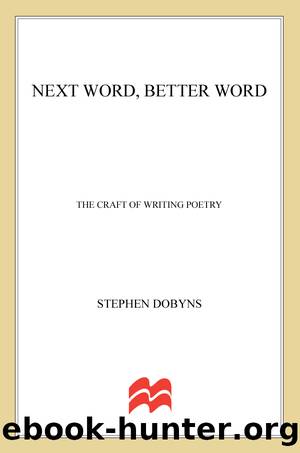Next Word, Better Word by Stephen Dobyns

Author:Stephen Dobyns
Language: eng
Format: epub
Publisher: St. Martin's Press
Published: 2011-09-14T16:00:00+00:00
eight
closure
in human affairs, the word “closure” means putting something behind us; in a successful poem, it can mean the invocation of something ahead. This apparent paradox points to one of a poem’s greatest strengths. The poem doesn’t end; rather, it gives back meaning with each rereading. Without such an ending, the poem is in danger of suffering closure in the conventional sense. It won’t transcend its syntactic closure; it won’t be more than the sum of its parts.
A lyric poem is a symbol of affective life, the realm of feelings. It was written because the poet has experienced an emotion about which he or she was unable to remain silent. The poet bears witness to that emotion and attempts to recreate it in the reader by presenting pertinent information equally in form and content. That act of bearing witness is what draws us to the poem as readers. If we don’t find that emotional dynamic, we may take pleasure in other elements, such as form, intelligence, quality of writing, strength of imagery, and so on, but none will take the place of the symbol of affective life. Indeed, if we grasp that symbol and the other elements are poorly executed, we will still value it more than a poem in which the reverse is true.
In a good poem we expect the emotional dynamic to transcend the particulars of the poet’s life in order to speak to the reader’s life. The reader doesn’t come to the poem out of curiosity about the poet, but in search of evidence for his or her own life. However, the poet must do more than bear witness to an emotional dynamic, which is why Philip Larkin said that a poem must be theatrical in operation. If the poet is writing because he or she is unable to remain silent, we expect the strength of that emotion to energize the poem. In the making of the poem, that emotion is translated into the poem’s theatrical dynamic. This doesn’t mean that the poem must be loud, but it must live up to the promise of its speaking.
The poem as symbol shares a symbol’s characteristics: it is nondiscursive; it is a product of the right brain; it is more than the sum of its parts; and it usually presents its information through sense data. In a poem, unlike an anecdote, the reader’s question—“What does this mean?”—is not fully answered by its syntactic closure. We have a sense of more, and so we move past the syntactic closure to reread the poem in search of the scope of that “more.” But no matter how much we reread, the poem continues to defy paraphrase. It remains dynamic, a living thing. Like any successful symbol, it continues to give back information, to transmit meaning. We may tire of it, but we can never exhaust it.
Look at Billy Collins’s “The Dead” from Sailing Alone Around the Room:
The dead are always looking down on us, they say,
while we are putting on our shoes
Download
This site does not store any files on its server. We only index and link to content provided by other sites. Please contact the content providers to delete copyright contents if any and email us, we'll remove relevant links or contents immediately.
Cecilia; Or, Memoirs of an Heiress — Volume 1 by Fanny Burney(32434)
Cecilia; Or, Memoirs of an Heiress — Volume 2 by Fanny Burney(31871)
Cecilia; Or, Memoirs of an Heiress — Volume 3 by Fanny Burney(31854)
The Lost Art of Listening by Michael P. Nichols(7406)
Asking the Right Questions: A Guide to Critical Thinking by M. Neil Browne & Stuart M. Keeley(5635)
We Need to Talk by Celeste Headlee(5542)
On Writing A Memoir of the Craft by Stephen King(4863)
Dialogue by Robert McKee(4321)
Pre-Suasion: A Revolutionary Way to Influence and Persuade by Robert Cialdini(4149)
I Have Something to Say: Mastering the Art of Public Speaking in an Age of Disconnection by John Bowe(3840)
Elements of Style 2017 by Richard De A'Morelli(3307)
The Book of Human Emotions by Tiffany Watt Smith(3238)
Fluent Forever: How to Learn Any Language Fast and Never Forget It by Gabriel Wyner(3028)
Name Book, The: Over 10,000 Names--Their Meanings, Origins, and Spiritual Significance by Astoria Dorothy(2939)
Good Humor, Bad Taste: A Sociology of the Joke by Kuipers Giselinde(2903)
Why I Write by George Orwell(2874)
The Art Of Deception by Kevin Mitnick(2736)
The Grammaring Guide to English Grammar with Exercises by Péter Simon(2710)
Ancient Worlds by Michael Scott(2625)
